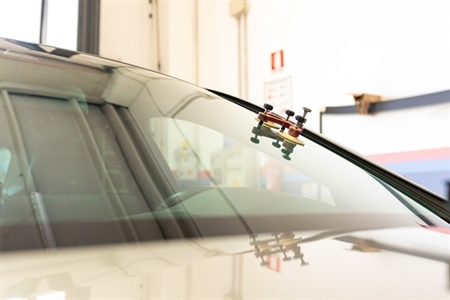The Role of OEM vs. Aftermarket Auto Glass in Replacement Quality

When it comes to replacing a damaged windshield or side window, the choice between original equipment manufacturer (OEM) glass and aftermarket options can affect fit, clarity, and performance.
At Glasswerks, our technicians see the difference every day in how precise manufacturing tolerances and factory-approved materials influence long-term reliability and driving experience. Whether you’re fixing a minor chip or scheduling a full auto glass replacement, understanding these two categories helps drivers make an informed decision.
This article examines key questions: how OEM and aftermarket auto glass differ in composition and installation, what impact each type has on vehicle safety, which option offers longer service life, how replacement costs compare, and why OEM glass is the preferred choice for vehicles equipped with advanced driver assistance systems (ADAS).
By exploring each topic, readers gain a clear picture of performance trade-offs, safety implications, and value considerations before choosing new auto glass.
How OEM and Aftermarket Auto Glass Differ
OEM auto glass is produced by the original vehicle manufacturer or approved supplier, matching exact specifications for curvature, thickness, and optical clarity. Aftermarket glass comes from independent manufacturers and may vary in tolerances, edge profiles, and lamination quality. These differences affect fit, sealing, and how the glass integrates with vehicle sensors.
Factory-grade adhesives and attachment points ensure OEM glass bonds precisely to the vehicle frame, preserving the windshield’s structural role in roof support and airbag deployment. Aftermarket options can use generic sealants and molding processes, resulting in minor gaps or stress points that may affect noise levels and water resistance.
Choosing OEM means you receive the glass that meets original crash and durability tests. If you opt for auto glass replacement with aftermarket pieces, verify the supplier’s quality certifications and warranties to ensure safe, long-lasting performance.
Impact of OEM vs Aftermarket Glass on Vehicle Safety
Windshields contribute up to 60% of a vehicle’s roof strength in a rollover; OEM glass is engineered and tested to meet precise safety standards. Its lamination and adhesives are validated for impact resistance, ensuring that shards remain adhered to the interlayer on collision.
Aftermarket variants may not undergo the same rigorous crash testing, leading to variations in break patterns and bond strength. Inconsistent lamination can allow glass separation during impact, increasing the risk of ejection or roof collapse in severe accidents.
Proper installation is crucial regardless of glass origin. Certified technicians follow manufacturer-approved procedures to maintain safety performance, using calibrated tools and adhesives that meet industry standards for bond strength and curing time.
Longevity Comparison: Which Auto Glass Lasts Longer?
OEM windshields often outlast aftermarket alternatives due to superior materials, consistent lamination processes, and stricter quality control. UV-resistant interlayers and tempered glass factors contribute to reduced discoloration and edge degradation over time.
Aftermarket glass lifespan varies by supplier; budget options may be more prone to stress cracks and delamination in extreme temperatures. Premium aftermarket brands that adhere to OEM specifications can approach similar durability but may still lack matching finish and fit precision.
Routine maintenance—such as proper cleaning with non-abrasive agents and timely chip repairs—extends the life of any windshield. Understanding the original glass specs helps set realistic expectations for longevity and performance.
Cost Comparison Between OEM & Aftermarket Glass
OEM glass carries a higher upfront cost reflecting factory tooling, engineering, and testing expenses. Installation labor for precise fit and manufacturer-approved sealants can also increase total replacement charges.
Aftermarket glass typically offers a lower sticker price, appealing to budget-conscious drivers and insurance policies seeking cost savings. However, lower costs may come with compromises in fit, finish, and potential additional labor if adjustments are needed.
When evaluating cost, consider long-term value: OEM replacements may reduce the likelihood of leaks, wind noise, and future repairs. Warranty coverage on factory parts often extends beyond that of generic alternatives, offsetting initial price differences.
Why OEM Glass Is Recommended for ADAS-Equipped Vehicles
Advanced driver assistance systems (ADAS) rely on precise sensor and camera alignment through the windshield. OEM glass features exact optical properties and mounting points designed for calibrated performance of lane-keep assist, automatic braking, and rain-sensing wipers.
Aftermarket windshields may exhibit slight distortions or incorrect thickness that disrupt sensor fields of view, leading to miscalibration or false alerts. Proper ADAS function requires glass that matches the original refractive index and curvature.
Following replacement with OEM glass, certified technicians perform ADAS recalibration to realign sensors with vehicle systems. GlassWerks provides factory-grade recalibration services to restore full safety feature accuracy.
Contact GlassWerks for Expert Auto Glass Solutions
Since 2009, GlassWerks has delivered quality OEM and aftermarket auto glass services from our St. Cloud location. Our certified technicians handle everything from standard windshield repairs to precise ADAS recalibrations, ensuring every replacement meets factory standards.
Stop compromising on safety or performance. Reach out today at 320-203-7777 or contact us to schedule your service at 3900 Roosevelt Road Suite 105, St Cloud, MN 56301.